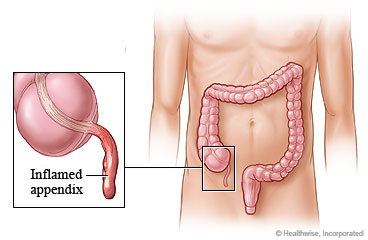
Overview
Your doctor thinks your child may have appendicitis. This means that your child's appendix may be infected. The appendix is a small sac that is shaped like a finger. It's attached to the large intestine.
Sometimes it's hard to tell if someone has appendicitis. If the doctor thinks it's possible that your child has it, more tests may be ordered. Or your doctor may want to wait to see if the symptoms change.
Your doctor thinks it's okay for you to take your child home right now. But you will need to watch for symptoms of appendicitis at home. If your child's symptoms continue or get worse, it's important to call your doctor or get medical care right away. Appendicitis can get serious very quickly. The main treatment is surgery to remove the appendix.
Follow-up care is a key part of your child's treatment and safety. Be sure to make and go to all appointments, and call your doctor if your child is having problems. It's also a good idea to know your child's test results and keep a list of the medicines your child takes.
How can you care for your child at home?
- Do not let your child eat or drink anything, unless your doctor says it is okay. If your child needs surgery, it's best to have an empty stomach. If your child is thirsty, have your child rinse their mouth with water.
- Do not give your child laxatives. They can make the appendix burst if your child has appendicitis.
- Follow the doctor's instructions about giving your child medicines. The doctor may tell you not to give your child antibiotics or pain pills. These medicines can make it harder to tell if your child has appendicitis.
- Watch for symptoms of appendicitis, such as severe belly pain, fever, nausea, and vomiting. It is very important that you follow the doctor's instructions about getting treatment if your child has these symptoms.
When should you call for help?
Call your doctor now or seek immediate medical care if:
- Your child has new or worse belly pain. Or the pain has become focused in one area of your child's belly.
- Your child has nausea and does not want to eat.
- Your child is vomiting.
- Your child has a fever.
- Your child cannot pass stools or gas.
Watch closely for changes in your child's health, and be sure to contact your doctor if:
- Your child does not get better as expected.
Where can you learn more?
Go to http://www.healthwise.net/patientEd
Enter K598 in the search box to learn more about "Possible Appendicitis in Children: Care Instructions".
Current as of: July 31, 2024
Author: Ignite Healthwise, LLC Staff
Clinical Review Board
All Ignite Healthwise, LLC education is reviewed by a team that includes physicians, nurses, advanced practitioners, registered dieticians, and other healthcare professionals.

